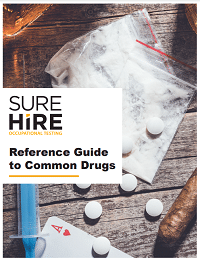TAKEAWAY: There are several compelling reasons to choose an expanded drug panel such as the 13-panel test. The 13-panel drug test screens for commonly misused prescription drugs and illegal substances including Amphetamines, Barbiturates, Benzodiazepines, Cannabinoids, and more.
Jump Ahead
According to recent statistics, 21% of Canadians meet the criteria for addiction. However, as most employers know, addiction is just one of the issues related to the illicit use of both illegal and legal drugs in the workplace. Safety, productivity, and absenteeism are also top of mind. Drug tests can help protect workers and the public, but they are only as effective as the drugs they are designed to detect. Leveraging a comprehensive test such as the 13-panel drug test can help ensure that safety issues in the form of drugs or alcohol misuse do not slip through unnoticed. Here is what you need to know about the 13-panel drug test.

Book A 13-Panel Drug Test
SureHire provides drug and alcohol testing services across North America and leverages the latest technologies to ensure accessibility and flexibility for your testing program and can help you select the right testing panel for your organization. SureHire also provides extensive support services alongside testing. SureHire’s drug and alcohol testing services help manage the risks associated with workplace substance abuse, incidents, and costly WCB claims and successfully rehabilitate your workers.
Which Substances Does the 13-Panel Drug Test Detect?
The 13-panel drug test screens for commonly misused prescription drugs and illegal substances and 2 drugs widely prescribed to treat addictions. These drugs, buprenorphine, and methadone, can be effectively prescribed and used, under a physician’s direction, to alleviate the effects of opiate withdrawal.
However, buprenorphine and methadone are also opioids. They can be misused or present a safety risk, particularly when taken at levels higher than the prescribed amount or combined with alcohol. The thirteen-panel drug test can identify the presence of both buprenorphine and methadone. A medical review officer (MRO) will investigate to determine if that use exceeds acceptable limits for addiction treatment.
The 13-panel drug test screens for:
- Amphetamines
- Barbiturates
- Benzodiazepines
- Cannabinoids
- Cocaine
- Methaqualone
- Opiate
- Phencyclidine
- Methadone
- Propoxyphene
- Buprenorphine
- Oxycodone
- Hydrocodone
Pros and Cons of the 13-Panel Drug Test
While the most commonly used test is the 8-panel drug test, there are several compelling reasons to choose an expanded panel such as the 13-panel. As with most drug tests, workplaces include the 13-panel test in pre-employment, random, post-incident, and other drug testing programs.
The growing use of a wide variety of synthetic drugs alongside the abuse of prescription medications that have sparked the recent opioid epidemic has expanded both the type and availability of drugs of abuse. And the use of one drug of abuse often leads to abuse of others as users seek a better high or easier access. A traditional approach involving a 5-panel test or simply focusing on known drugs may not be enough to protect a company, its workers or the public. And in cases where there is suspected drug use within a company, a 13-panel testing program is a practical and proactive approach to risk reduction.
However, a 13-panel test is not always necessary. To select the test that best fits your company’s needs, consider your industry, corporate culture, applicable laws and compliance regulations. [Read more in 9 keys to an Effective Drug and Alcohol Policy]
POCT vs Lab-Based Testing?
13-panel drug tests are available to organizations as either lab-based tests or point of care (POCT), also known as express testing.
Lab-based tests are considered to be more accurate and reliable than POCT tests. However, they can be more time-consuming. Samples must be collected by technicians and then sent to a laboratory for testing. This process can take several days.
POCT tests can deliver results quickly, often within minutes, and employers can easily administer them on-site. Because of this, they tend to be more convenient for workers and less expensive for employers.
Laboratory tests must confirm positive POCT tests to eliminate the possibility of a false positive and help ensure legal defensibility for any actions taken by the employer.
Employing a Medical Review Officer (MRO) for either lab-based or POCT testing can also protect the company.
What are Windows of Detection?
Windows of detection refer to the period in which tests can detect a drug in the system. They vary depending on the type of drug test and the drug it is testing for. It can also be affected by usage. Heavy use of certain drugs, such as cannabis, can be detected for longer than casual use.
Oral fluid testing offers a much shorter detection window, usually 12 to 24 hours, but it is an excellent method for detecting current impairment. Here are the windows of detection for several classes of drugs:
| Drug/Classes of Drugs | Windows of Detection – Urine (days) | Windows of Detection – Oral Fluid (days) |
| Marijuana metabolite | 3-15 | 1-2 |
| Cocaine metabolite | 1-7 | 1-2 |
| Opioids -Codeine -Morphine -Hydrocodone -Hydromorphone -Oxycodone -Oxymorphone | 1-3 1-3 1-3 1-3 1-3 1-3 | 1-2 1-2 1-2 1-2 1-2 1-2 |
| 6-Acetylmorphine | <1 | <1 |
| Methaqualone | 1-4 | 1-15 |
| Phencyclidine | 2-30 | 1-20 |
| Amphetamines -Amphetamine -Methamphetamine -MDMA | 2-4 1-4 1-3 | 1-3 1-3 1-2 |
| Methadone Buprenorphine Barbiturates Propoxyphene | 1-3 3-5 3-10 1-7 | 1-2 1-2 1-2 1-2 |
What does “Cut-off level” mean?
Cut-off levels indicate when the concentration of a drug within a person’s system, via a the POCT or lab-based test, demonstrates a safety risk. Organizations can set acceptable cut-off levels and typically identify them in the company drug and alcohol testing policy.
In Canada, most cut-off levels are based on either the Canadian Model or the US Department of Transportation (DOT) concentration limits.
There are different cut-off levels depending on the type of test and the drug it tests. There are also initial screening and confirmation test levels. The latter is usually slightly lower.
The Canadian Model is silent on the cut-off levels for methadone, buprenorphine, barbiturates, and propoxyphene. However, standard cut-off levels for each drug are included in the chart below.
Urine Drug Cut-off Limits
| Drug/Classes of Drugs | Screening Concentration (ng/ML) | Confirmation Concentration (ng/ML) |
| Marijuana metabolite | 50 | 15 |
| Cocaine metabolite | 150` | 100 |
| Opioids -Codeine -Morphine -Hydrocodone -Hydromorphone -Oxycodone -Oxymorphone | 2000 2000 300 300 100 100 | 2000 2000 300 300 100 100 |
| 6-Acetylmorphine | 10 | 10 |
| Methaqualone | 300 | 300 |
| Phencyclidine | 25 | 25 |
| Amphetamines -Amphetamine -Methamphetamine -MDMA | 500 | 250 250 250 |
| Methadone Buprenorphine Barbiturates Propoxyphene | 300 5 200 300 1000 | 200 |
Oral Fluid Testing Limits
| Drug/Classes of Drugs | Screening Concentration (ng/ML) | Confirmation Concentration (ng/ML) |
| Marijuana THC | 4 | 2 |
| Cocaine metabolite – Cocaine or benzoylecgonine | 20 | – 8 |
| Opioids -Codeine -Morphine -Hydrocodone -Hydromorphone -Oxycodone -Oxymorphone | 40 | 40 40 40 40 40 40 |
| 6-Acetylmorphine | 4 | |
| Phencyclidine | 10 | 10 |
| Amphetamines -Amphetamine -Methamphetamine -MDMA -MDA | 50 | 50 50 50 50 |

You May Also Be Interested In…
- Do You Have Reasonable Suspicion?
 Employers cannot initiate reasonable suspicion testing without first going through the 5-step process. Reasonable suspicion training provides critical information about how to initiate reasonable suspicion testing, including the 5-step process and other tools that employers can use to help manage the misuse of alcohol and drugs in the workplace.
Employers cannot initiate reasonable suspicion testing without first going through the 5-step process. Reasonable suspicion training provides critical information about how to initiate reasonable suspicion testing, including the 5-step process and other tools that employers can use to help manage the misuse of alcohol and drugs in the workplace. - An Employer’s Guide: What You and Your Employees Need to Know About DOT Drug & Alcohol Testing
 When implementing or maintaining DOT Drug & Alcohol testing, there are key areas that employers should consider.
When implementing or maintaining DOT Drug & Alcohol testing, there are key areas that employers should consider. - SureHire Occupational Testing Acquires COHR Health: A Positive Step Towards Safe, Healthy, Productive Workforces and Communities
 We are thrilled to announce that today, May 6, 2024, SureHire Occupational Testing has officially acquired COHR Health, a well-known leader in occupational health services. Read on…
We are thrilled to announce that today, May 6, 2024, SureHire Occupational Testing has officially acquired COHR Health, a well-known leader in occupational health services. Read on… - Occupational Testing Use Case – Mining
 In this case study, we will explore how mining companies can use various types of occupational tests to reduce Total Recordable Incident Rates (TRIR) long term.
In this case study, we will explore how mining companies can use various types of occupational tests to reduce Total Recordable Incident Rates (TRIR) long term. - 9 Strategies to Keep Workers Cool on Drilling Sites During Hot Summer Months
 This article delves into strategies to keep workers cool and safe on drilling sites during the hot summer months.
This article delves into strategies to keep workers cool and safe on drilling sites during the hot summer months. - Hearing Conservation Basics: How to Manage Occupational Noise
 Learn how to proactively mitigate occupational noise risks and help prevent NIHL among workers.
Learn how to proactively mitigate occupational noise risks and help prevent NIHL among workers.

